Did you know that Jupiter has 80 known moons? Learn about the largest planet in our solar system with these fascinating facts about Jupiter.
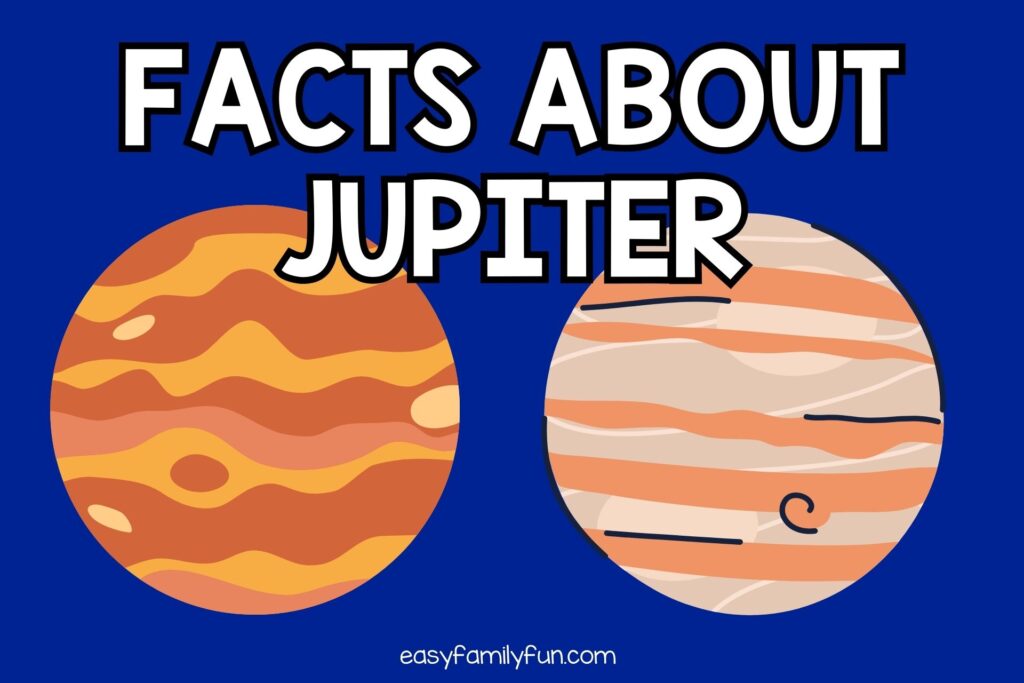
Jupiter has long captured the imagination of astronomers, scientists, and my son. My oldest has always been fascinated with space. From rocket launches to all things about our solar system.
Facts are indeed a great way to enjoy and appreciate the wonders of the world around us. They spark our curiosity and provide us with valuable knowledge and insights. When it comes to a fascinating subject like Jupiter, facts can take us on a journey of discovery, allowing us to marvel at the sheer scale and complexity of this magnificent planet.
So, buckle up and get ready to immerse yourself in a collection of mind-boggling facts about Jupiter that will leave you awestruck and eager to explore more.
Love space?! Be sure to check out our 103 Super Cool Facts About Space
85 Stellar Facts About Jupiter

- Jupiter is the fifth planet from the sun and is the largest in our solar system.
- The three biggest planets in our solar system are Jupiter, followed by Saturn and Uranus.
- This super-sized planet is 142,800km in diameter.
- Jupiter is over 11 times wider than Earth.
- While a day on Earth is 24 hours long, one day on this gigantic planet is only about 10 hours.

- It takes Jupiter the equivalent of almost 12 Earth years to years to orbit the Sun.
- Jupiter is one of two gas giants in our solar system.
- Like Saturn, it is mostly made up of hydrogen and helium gasses and doesn’t have a true surface like Earth. Instead, these swirling gasses move around a solid core.
- You wouldn’t be able to fly a spaceship into the atmosphere. Because of the extreme conditions and temperatures, a craft would be crushed and melted before it could get far.
- Scientists think that the atmospheric pressure is so great that the gas hydrogen is compressed into a liquid state, so there are oceans of hydrogen!
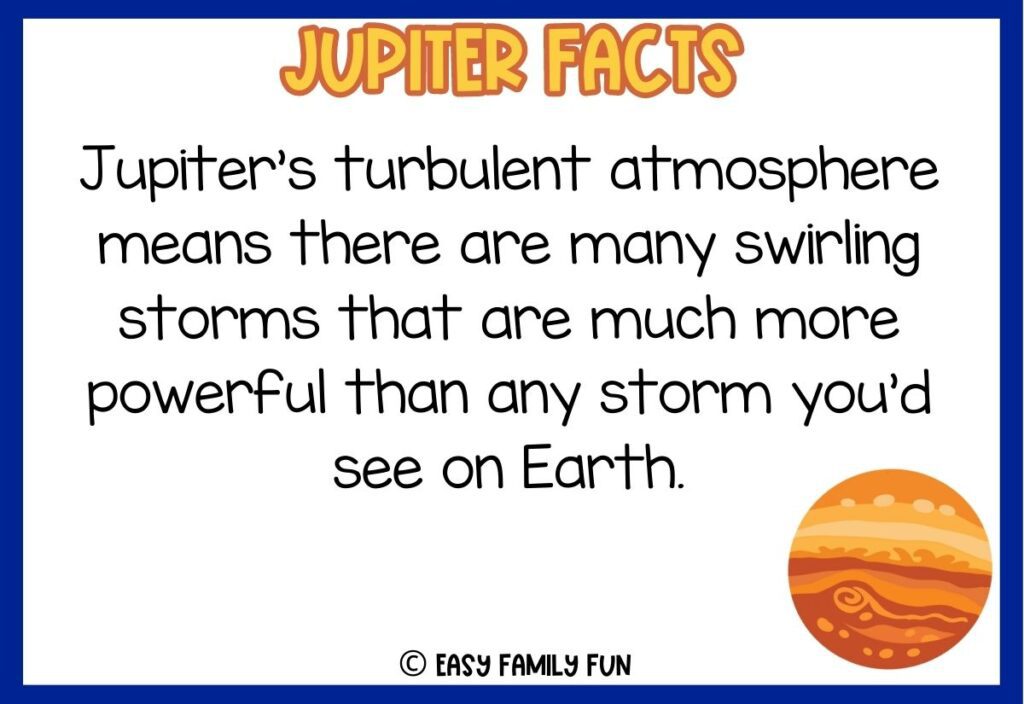
- Jupiter’s turbulent atmosphere means many swirling storms are much more powerful than any storm you’d see on Earth.
- One storm – known as the Great Red Spot – is large enough to engulf Earth and astronomers have been keeping an eye on this massive storm for hundreds of years.
- While Earth only has one moon, scientists think Jupiter has 80-95 moons.
- Jupiter has four large moons. They are Io, Europa, Ganymede and Calisto, and they were first observed in 1610 by Galileo Galilei.
- The moon Ganymede is the largest moon in the solar system and in the 1990s scientists discovered that this moon has an underground saltwater ocean so large that has more water than all the oceans of Earth combined.

- This planet is named after the Roman sky god, Jupiter. He was main Roman god and the Romans believed he watched over all aspects of life.
- From Galileo Galilei using one of the earliest telescopes to observe Jupiter in the 17th century, to the powerful Hubble telescope which was launched into space in the 1990s, humans have been watching Jupiter for hundreds of years.
- However, scientists have learned so much more since the Juno spacecraft began orbiting around Jupiter in 2016 and sending data back to scientists on Earth.
- Jupiter is SO massive that you could put all of the other planets inside—twice over!
- Jupiter’s inner core is close to the size of Earth.

- While Jupiter cannot support life, some of its moons might be able to do so, given the oceans beneath the surface.
- Its rotation is faster than any other planet, creating streaks: dark areas (belts) indicate rising clouds and gases; light areas (zones) indicate where belts sink.
- It spins fast at its equator and slowly at its poles; where the momentums clash, gaseous layers produce violent eddies, curlicues, swirls, white spots, and the famous Great Red Spot.
- Jupiter has four rings! They were discovered by the Voyager 1 spacecraft in 1979.
- The rings are very faint and made of small dust particles unlike Saturn’s visible rings which are made of large icy and rock chunks.
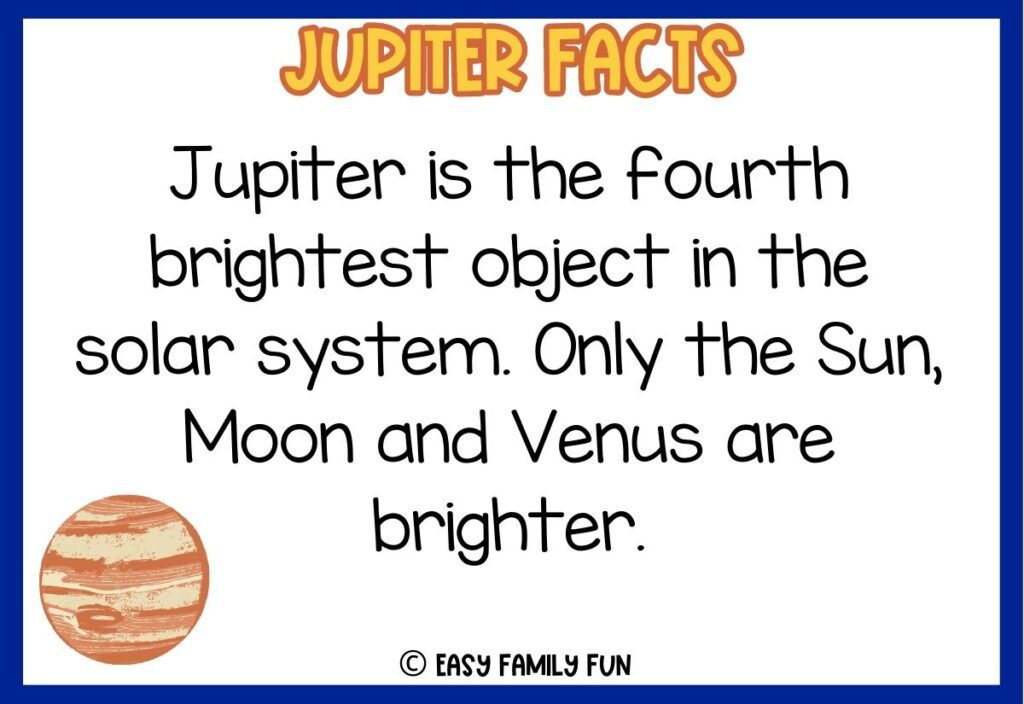
- Jupiter is the fourth brightest object in the solar system. Only the Sun, Moon and Venus are brighter.
- It is one of five planets visible to the naked eye from Earth.
- The ancient Babylonians were the first to record their sightings of Jupiter.
- To the Greeks, Jupiter represented Zeus, the god of thunder.
- The Mesopotamians saw Jupiter as the god Marduk and patron of the city of Babylon.
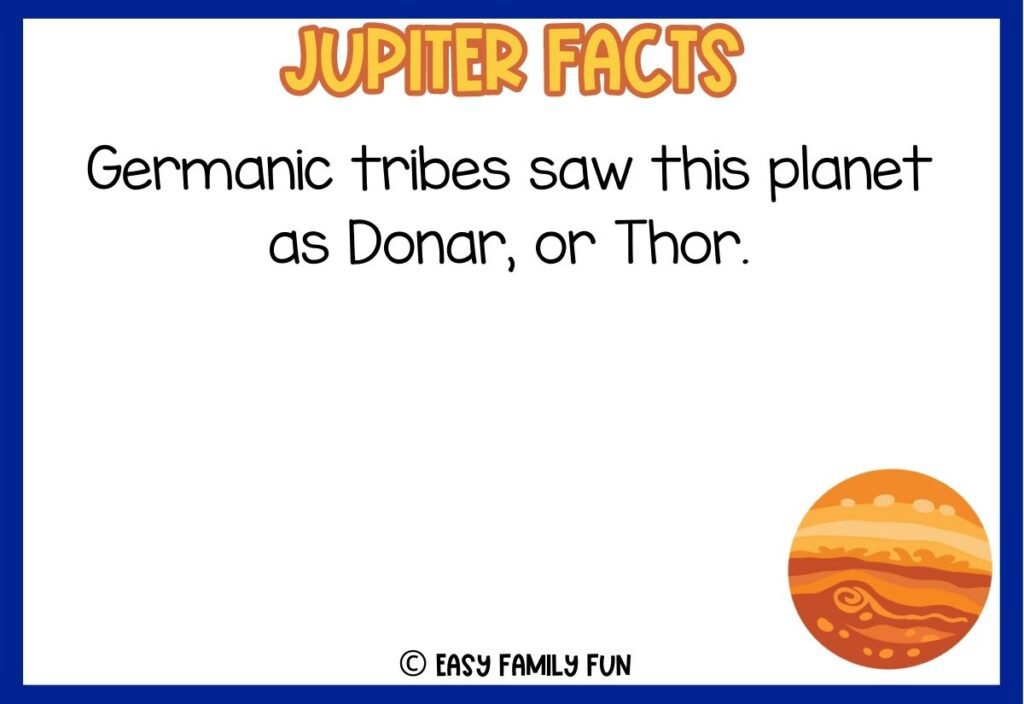
- Germanic tribes saw this planet as Donar, or Thor.
- Jupiter has the shortest day of all the planets.
- The rapid rotation flattens the planet slightly, giving it an oblate shape.
- Jupiter has unique cloud features.
- The upper atmosphere of Jupiter is divided into cloud belts and zones.
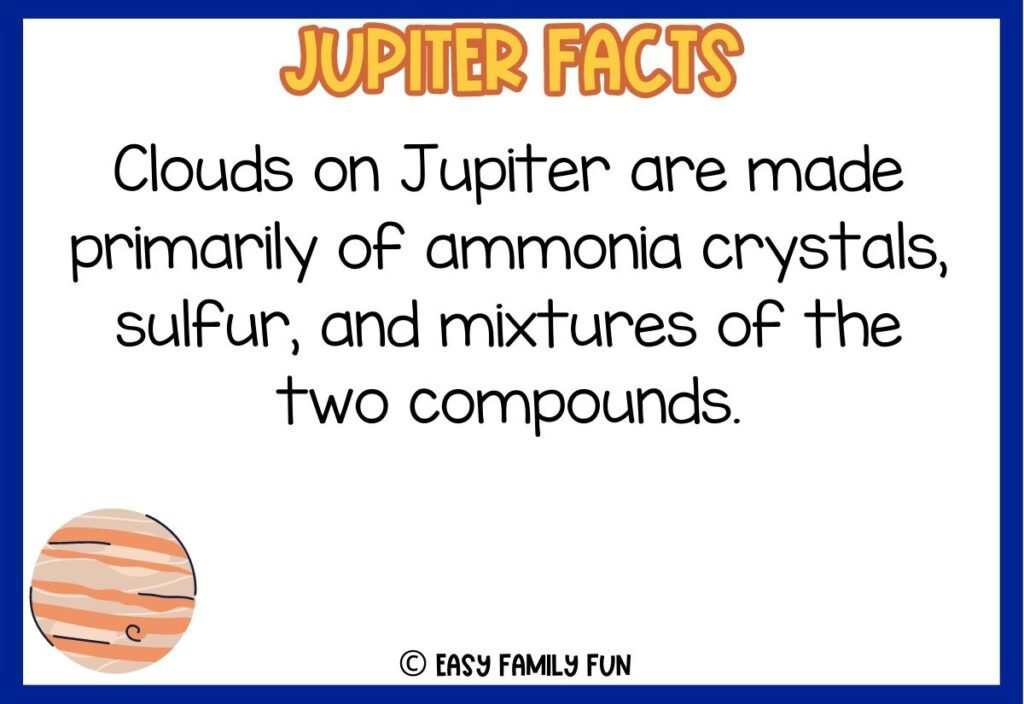
- Clouds on Jupiter are made primarily of ammonia crystals, sulfur, and mixtures of the two compounds.
- Jupiter’s interior is made of rock, metal, and hydrogen compounds.
- Below Jupiter’s massive atmosphere (which is made primarily of hydrogen), there are layers of compressed hydrogen gas, liquid metallic hydrogen, and a core of ice, rock, and metals
- Jupiter’s moon Ganymede is the largest moon in the solar system.
- Ganymeade measures 5,268 km across, making it larger than the planet Mercury.
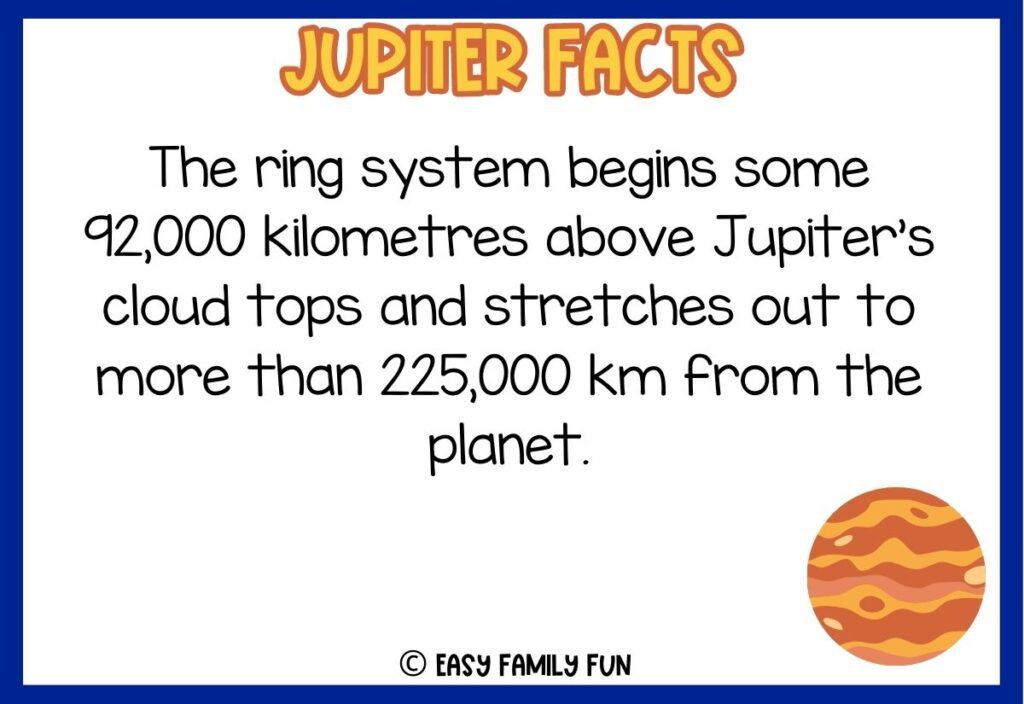
- The ring system begins some 92,000 kilometres above Jupiter’s cloud tops and stretches out to more than 225,000 km from the planet.
- Nine spacecraft have visited Jupiter.
- Jupiter has 2.4 times more gravity compared to the Earth
- If you weigh 100 pounds on Earth, your weight on Jupiter would be 240 pounds!
- Since Jupiter is a gaseous planet and does not have a well-defined surface, it is not suitable to sustain life.

- Jupiter is at an average distance of 778 million km from the Sun.
- This is about 5.2 times the distance from the Earth to the Sun.
- While it takes only about 8 minutes 30 seconds for sunlight to reach Earth, it reaches Jupiter in about 43 minutes 20 seconds.
- Jupiter is massive compared to the other planets and exerts its gravitational force to pull the center of mass (called the barycenter) between itself and the Sun.
- Jupiter is the only planet in the solar system with a barycenter outside of the surface of the Sun, which means it technically does not orbit the Sun!
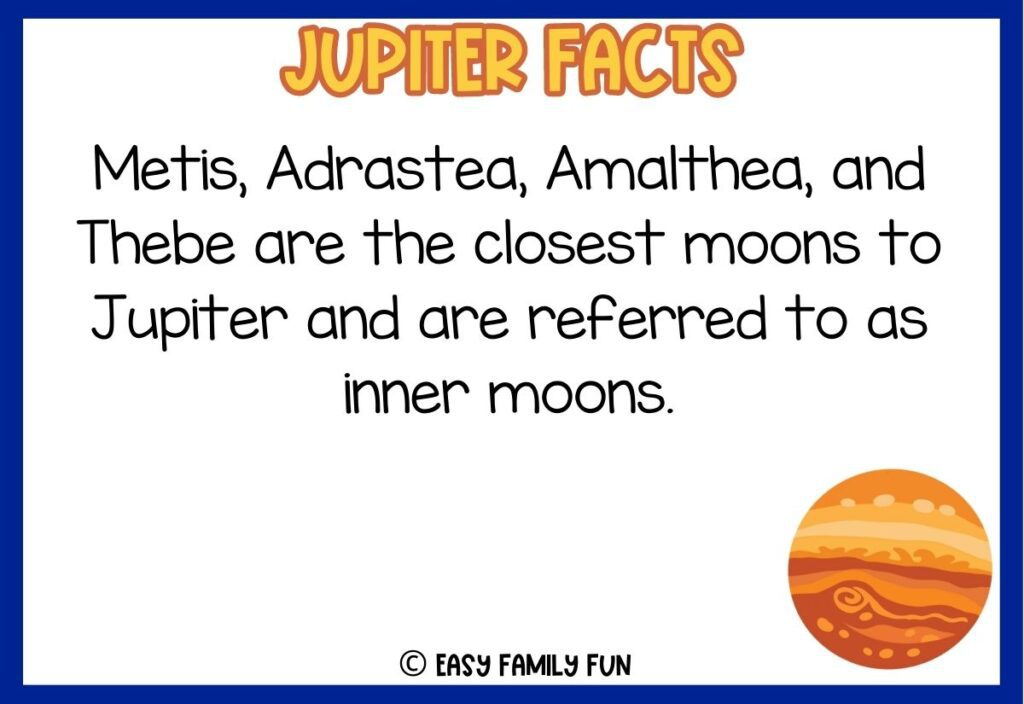
- Metis, Adrastea, Amalthea, and Thebe are the closest moons to Jupiter and are referred to as inner moons.
- Io, Europa, Ganymede, and Callisto are the largest moons of Jupiter and are together known as Galilean Moons
- Jupiter’s moon Io is the most volcanically active in the solar system.
- Some of its volcanoes are miles high and can be seen with large telescopes on Earth.
- 17th–century astronomers calculated the speed of light by studying Jupiter’s four large moons.
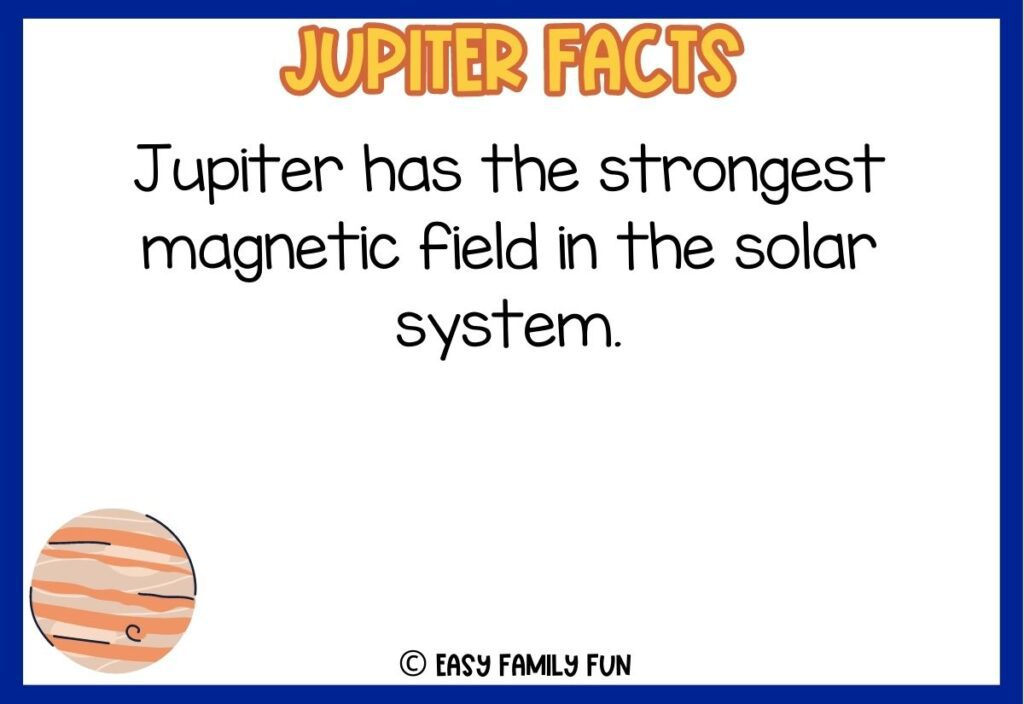
- Jupiter has the strongest magnetic field in the solar system.
- Thought to be generated by electric currents within Jupiter’s liquid outer core, it is responsible for enormous auroral displays that can create hundreds of times more energy than Earth’s northern and southern lights.
- Fragments of Comet Shoemaker-Levy 9 blasted into Jupiter in 1994. Astronomers from around the world witnessed this event through telescopes, marking the first time humans observed such a collision of solar system bodies.
- Jupiter is the destination for David Bowman, Frank Poole, and computer HAL in the movie 2001: A Space Odyssey.
- If Jupiter would be 75 times more massive than it currently is, it would become a star just like our Sun.
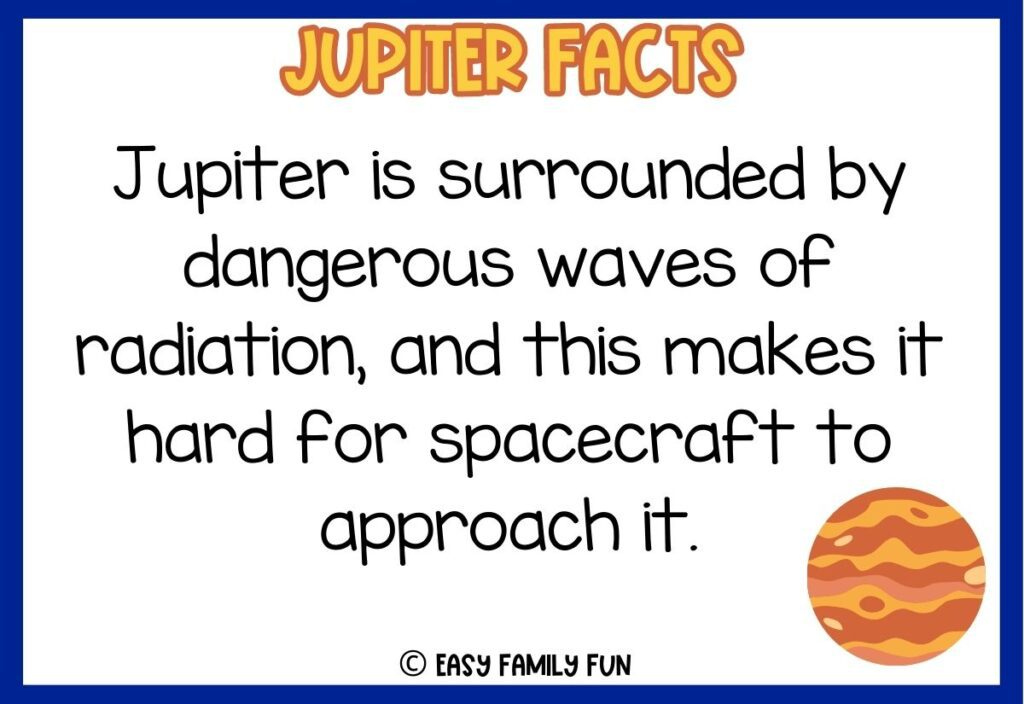
- Jupiter is surrounded by dangerous waves of radiation, and this makes it hard for spacecraft to approach it.
- The red spot on Jupiter was first seen in 1665 by an Italian astronomer named Giovanni Cassini.
- If you could go down on Jupiter, the thin, cold atmosphere would become thicker and hotter until it turns into a thick, dark fog.
- The pressure further down is so great that the gases become liquid.
- Though some consider Jupiter a failed star, it doesn’t have enough mass to trigger a fusion reaction in its core.

- Jupiter generates more heat than it receives from the Sun.
- Because of its mass, Jupiter generates high amounts of heat as it shrinks under gravity. It is unknown when Jupiter will stop shrinking.
- Jupiter has no way of becoming a star unless it would gain around 75 times more mass than it currently has.
- Scientists believe that Jupiter was twice its current size when it was formed.
- The giant planet is constantly bombarded with asteroids and comets, almost 200 times more than Earth.
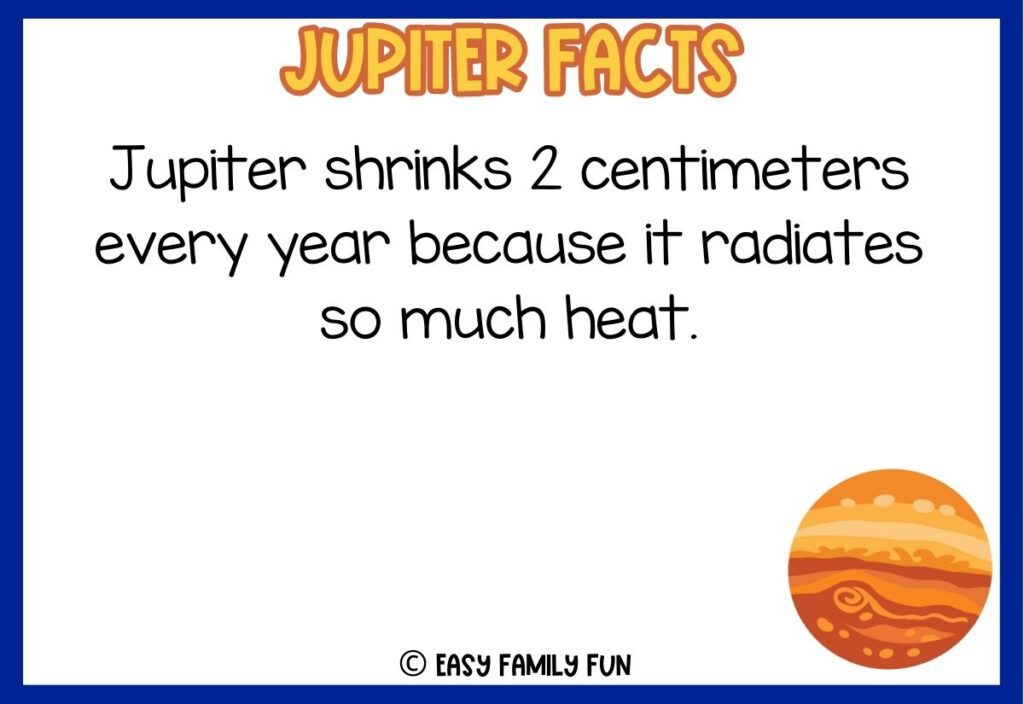
- Jupiter shrinks 2 centimeters every year because it radiates so much heat.
- Winds around the Great Red Spot’s oval edges at Jupiter can reach up to 680 km/h.
- Strong radio waves are emitted by Jupiter and can be easily detected from Earth.
- Blue clouds can be seen at the deepest visible levels of Jupiter’s atmosphere.
- The atmospheric pressure of Jupiter is 1000 times greater than that on Earth.
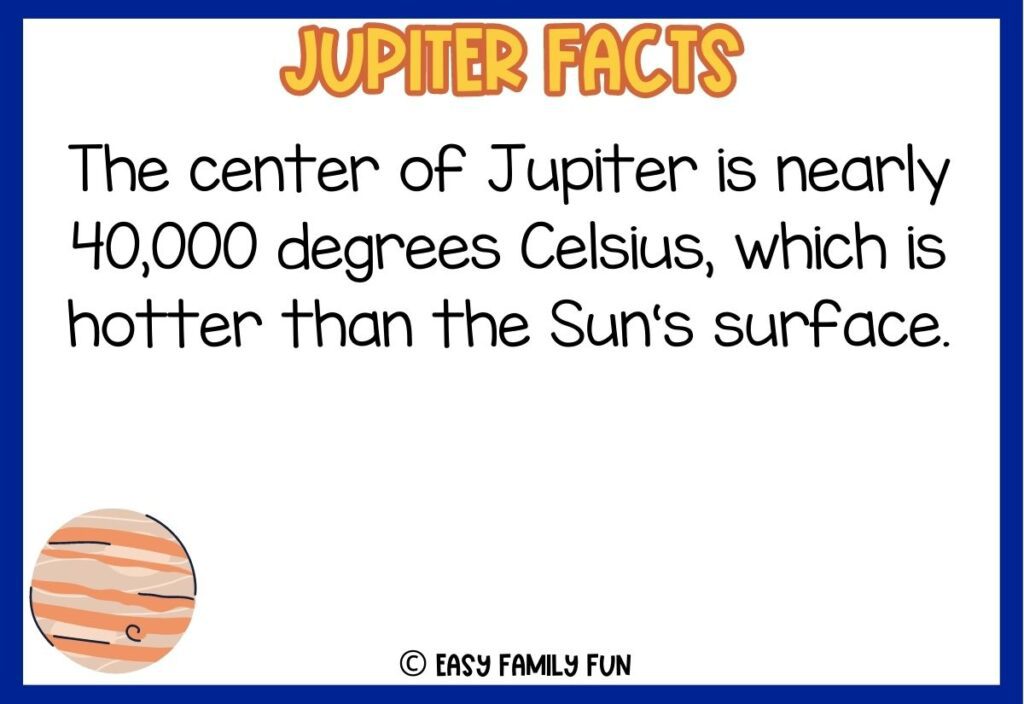
- The center of Jupiter is nearly 40,000 degrees Celsius, which is hotter than the Sun‘s surface.
- Jupiter was also known as Jove.
- Clouds on Jupiter are not similar clouds as on Earth. On Jupiter, clouds speed around the planet at up to 644 km per hour.
- Earth is 1 astronomical unit (AU) from the Sun. Jupiter’s average distance from the Sun is 5.2 AU.
- Jupiter is just over 11 times wider than Earth.
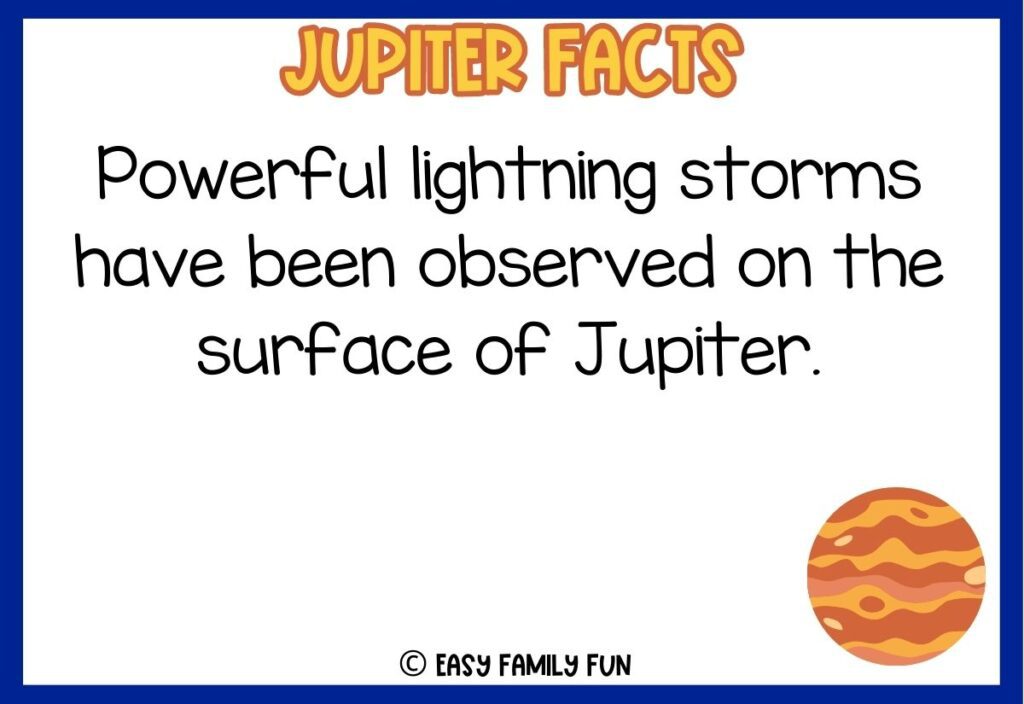
- Powerful lightning storms have been observed on the surface of Jupiter.
- The lightning is caused by convection that starts deep within the planet. Gases, including water vapor, form ice particles as they are rising. The ice particles in the rising gases rub past each other building a charge until they are discharged as lightning.
- While Jupiter often protects Earth and the other inner planets by deflecting comets and asteroids, sometimes it sends objects on a collision course straight toward the inner planets.
- The color of Jupiter is a mixture of browns, yellows, whites, reds and some orange.However, it’s surface color changes with changes in the atmosphere.
- Like the other planets, Jupiter does not orbit the Sun in a circle, but more of an oval (ellipse) pattern.
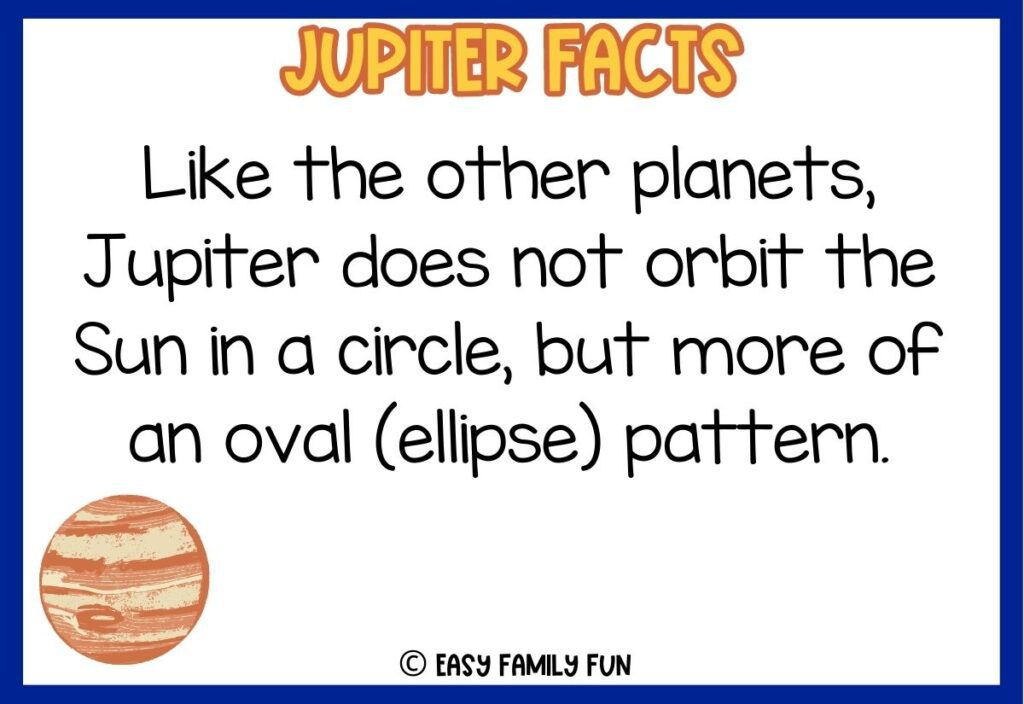
We hope you liked these fun facts about Jupiter! If you know any others, be sure to leave them in the comments so we can all learn.
Are you looking for more fun and engaging facts to share with your family? Check out these other posts for more facts!
- 100 Fascinating Facts about Mexico
- 75 Fascinating Facts About France
- 100 Purr-fectly Delightful Facts About Cats
- 87 Fascinating Facts About Owls
- 103 Super Cool Facts About Space
- 100 Interesting Facts About Hurricanes
- Facts About the 9/11 Memorial
- Facts About Spring
- Facts About Rosa Parks
- 50 Fascinating Facts About Butterflies
- 50 Fascinating Facts About Eagles
- Facts About Rome
- Facts About Lions
- Facts about Big Ben
- 100 Best Facts About Quartz for Kids
- 100 Best Facts About Cheese For Kids
- 100 Best Facts About Canada for Kids
- 100+ Out-of-This-World Facts about Earth
- 100 Epic Bug Facts for Kids
- 100 Weird Facts About Animals for Kids
- 85 Stellar Facts About Jupiter
- 135 Fascinating Facts About Ireland That Will Make You Fall in Love
- 50+ Interesting Facts about the Nervous System [Fact Cards]
- 55 Interesting Facts About Seattle [Free Fact Cards]
- 55 Best Facts about Frogs [Free Fact Cards]
- 66 Best Facts About Blueberries [Free Fact Cards]
- 37 Best Facts About Bacon [Free Fact Cards]
- 65 Best Facts About Comets [Free Fact Cards]
- 85+ Best Titanic Facts [Free Fact Cards]
- Interesting Facts about Ladybugs [Free Fact Cards]
- Abraham Lincoln Facts You Should Know [Free Fact Cards]
- Dive Into These Facts About Jellyfish [Free Fact Cards]
- Interesting Banana facts [Free Fact Cards]
- 20 Interesting Facts About Red Wolves [Free Fact Cards]
- Mt. Rushmore Facts: Carving History in Stone [Free Fact Cards]
- 66 Best Facts About Blueberries [Free Fact Cards]
- Over 100 Fun Facts about North Carolina [Free Fact Cards]
- 79 Electrifying Facts about Lightning [Free Fact Cards]
- 56 Interesting Facts About Snakes [Free Fact Cards]
- 56 Interesting Facts About Snakes [Free Fact Cards]
- 53 Fascinating Facts about Spiders [Free Fact Cards]
- 74 Interesting Facts About New Zealand [Free Fact Cards]
- 50 Interesting Facts About Apples [Free Fact Cards]
- 100 Purr-fectly Delightful Facts About Cats
- Buzzing with Knowledge: Explore 65 Fascinating Facts About Bees!
- 100 Marvelous Facts About Monkeys
- Gallop Through Knowledge: With These 75 Fascinating Facts about Horses
- Travel Back in Time With These Facts About the 13 Colonies!
- 52 Facts About Neptune for the Future Astronauts in Your Family
- 40 Incredible Facts About Your Heart
- 25 Remarkable Facts about James Madison
- 35 Oink-some Facts About Pigs
- 50 Neck-Stretching Facts about Giraffes
- 65 Patriotic Facts about the Statue of Liberty
- 50 Incredible Facts About Turtles
- 40 Mischievous Facts About Raccoons
- 135 Fascinating Facts About Ireland That Will Make You Fall in Love
- 85 Stellar Facts About Jupiter
- 100 Weird Facts About Animals for Kids
- 100 Epic Bug Facts for Kids
- 100+ Out-of-This-World Facts about Earth
- 100 Best Facts About Canada for Kids
- 100 Best Facts About Cheese For Kids
How Do I Access My Printable?
Fill in the form above. You will receive an email in your inbox. If you don’t see it, check your spam folder! You will then click to confirm your subscription. Once confirmed, you will be taken to Airtable (a different website) where all our free printables will be waiting for you! It is free to sign up for Air Table!
How Do I Print A PDF?
You’ll need a program that supports PDFs. Adobe Acrobat is a great option. Open the program, click file, then print. Select your printer and the number of copies you want to print. Be sure you click double-sided if you want it to print on both sides.
Can I Resell These?
You may not resell any printable found on our website or in our resource library. You may use them for class parties, at church, at home, or in the classroom. You may get these printed at an office supply store or copy center at your own expense.
